人教版(2019)必修第二册Unit4 History and Traditions Reading and thinking课件(23张ppt)
文档属性
| 名称 | 人教版(2019)必修第二册Unit4 History and Traditions Reading and thinking课件(23张ppt) | 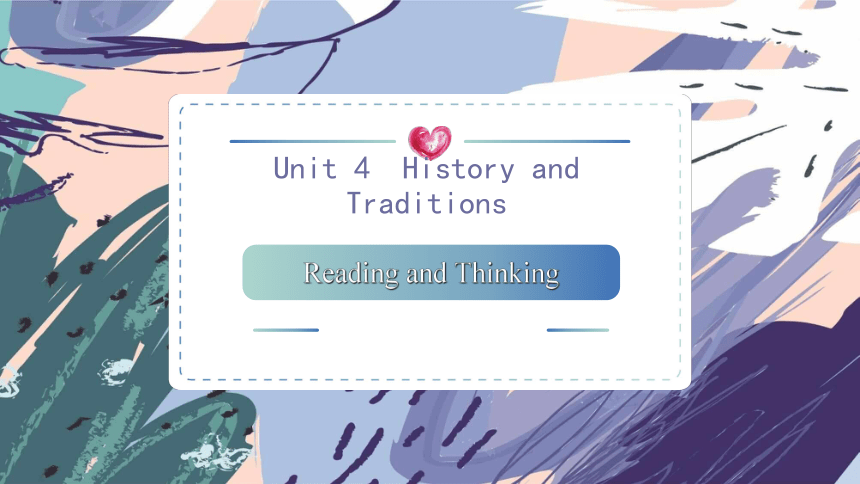 | |
| 格式 | zip | ||
| 文件大小 | 14.6MB | ||
| 资源类型 | 教案 | ||
| 版本资源 | 人教版(2019) | ||
| 科目 | 英语 | ||
| 更新时间 | 2022-04-02 23:53:40 | ||
图片预览



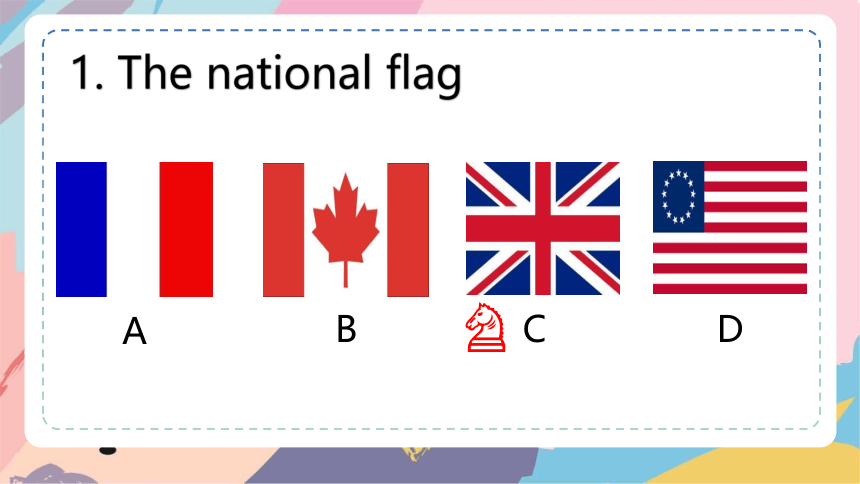
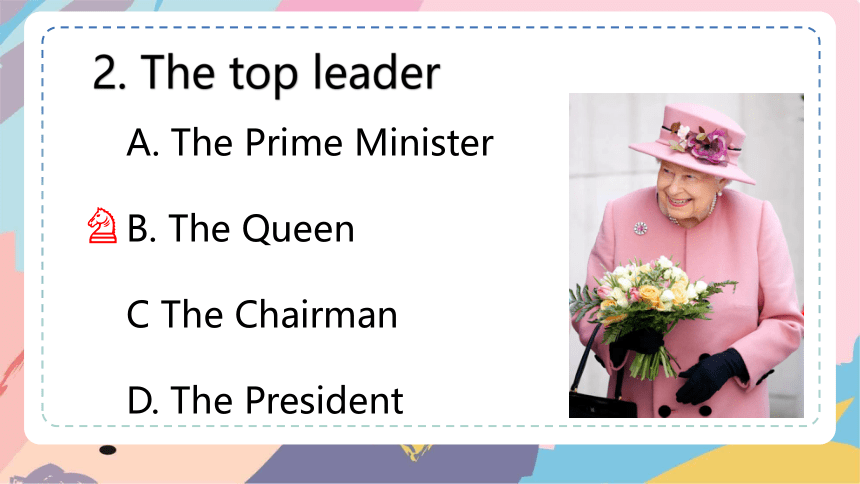
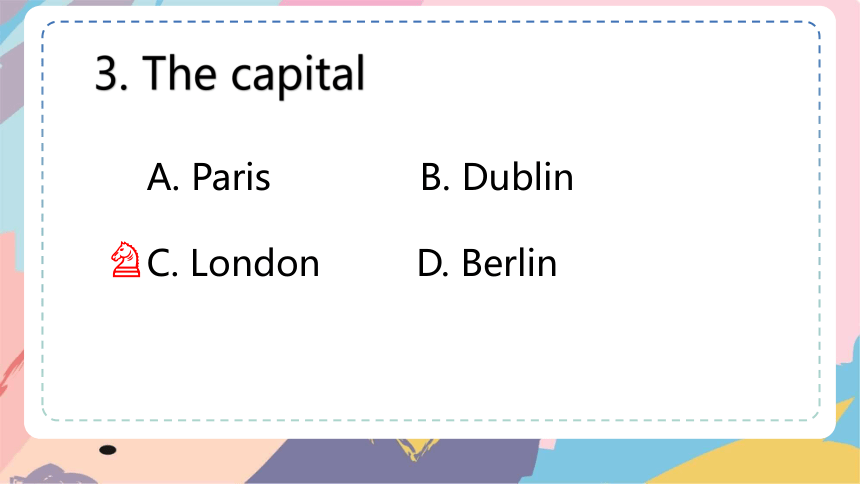
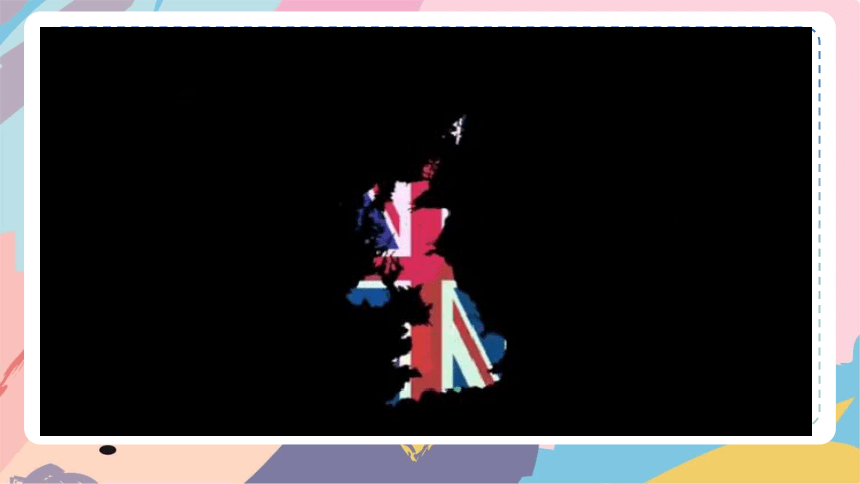
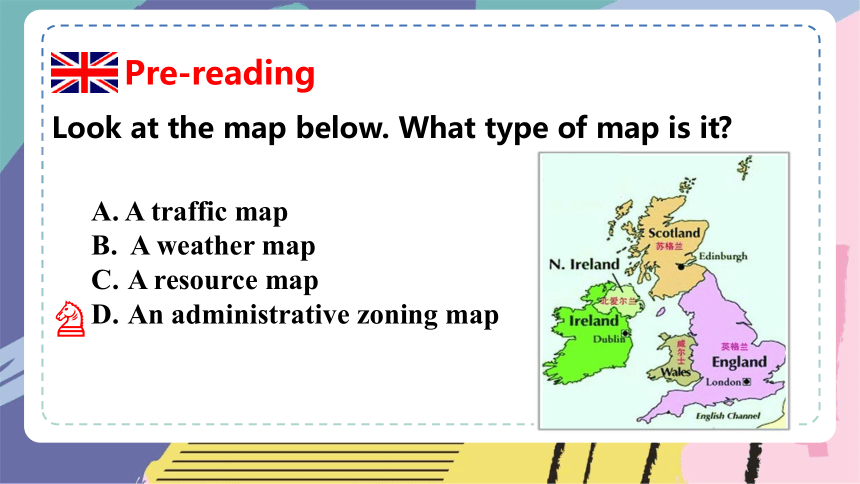
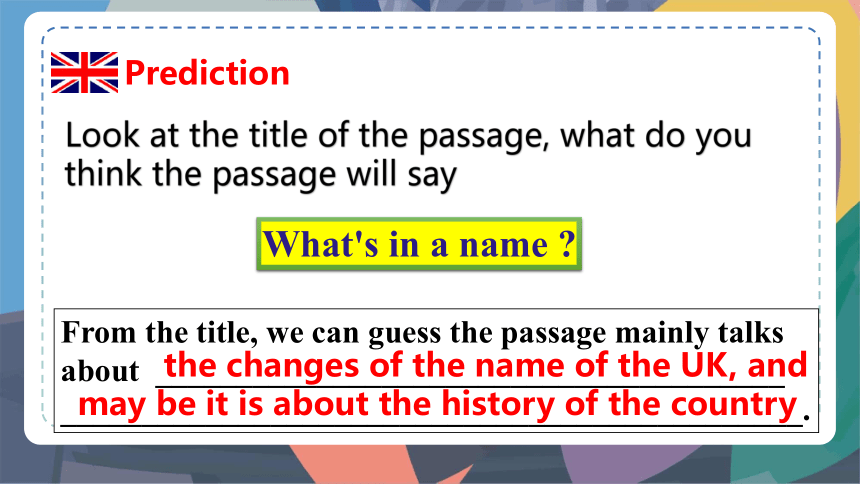
文档简介
(共23张PPT)
Unit 4 History and Traditions
Reading and Thinking
学习目标
Learn about the history of the UK and get the detailed information by answering some questions and finishing some tasks of it.
Learn to use the reading strategy—reading maps and predication from the title.
Retell the passage after finishing the timeline and mind map.
Lead-in
https://www./
A quiz about British
1. The national flag
A
B
C
D
2. The top leader
A. The Prime Minister
B. The Queen
C The Chairman
D. The President
3. The capital
A. Paris B. Dublin
C. London D. Berlin
Pre-reading
Look at the map below. What type of map is it
A traffic map
B. A weather map
A resource map
An administrative zoning map
Prediction
What's in a name
From the title, we can guess the passage mainly talks about _______________________________________
______________________________________________.
Look at the title of the passage, what do you think the passage will say
the changes of the name of the UK, and may be it is about the history of the country
While-reading
While-reading
Para. 1.
Para. 2.
Para. 3.
Para. 4.
Para. 5
Task 1 To find the main idea of each paragraph.
The formation and names of the United Kingdom
The four groups of people in the history of the UK
More history and culture of the United Kingdom
The similarities and differences of the four countries
Introduce the puzzle about the four names
The origin of the name
The four countries
The history
Part 1
Part 2
Part 3
The formation and names
names
history
history and culture
four countries
the
puzzle
Task 2 read the text and answer the questions
1)Which of the following correctly describes the four countries of the UK
A. They use the same flag but different money.
B. They have their own educations systems.
C. They celebrate the same holidays.
D. They share football teams for the World Cups.
2)What do we know about the four groups of people in the UK
A. The Romans’ achievements lay in building towns and castles.
B. The Anglo-Saxons created new types of houses.
C. The Vikings arrived in the eighteenth century.
D. The Normans had an influence on the English language.
3) What can we learn from the last paragraph
A. the UK has more interesting history than China.
B. Studying the history of the UK will benefit your visit there.
C. London’s history began from Roman times as an inland city.
D. Tourists should keep their eyes open while travelling in London.
When What happened What changed
Romans arrived
Ango-Saxons came
Vikings came
11th century
16th century
18th century
19th century
20th century
Task 3. Read again and sort out the information according to the timeline
England
the Kingdom of England
Para 2 The history of The UK
What’s the name of this part
16th century
Wales
When and What happened
18th century
When and what happened
Scotland
The name was changed to the Kingdom of Great Britain
19th century
Ireland
When and what happened
The name was changed to the United Kingdom of Great Britain and Ireland
When and what happened
20th century
Northern Ireland
=
England
Scotland
Ireland
the UK
The full name of the UK is the United Kingdom of Great Britain and Northern Ireland
When What happened What changed
Romans arrived
Anglo-Saxons came
Vikings came
11th century
16th century
18th century
19th century
20th century
1st century
5th century
8th century
Normans conquered England
Wales was joined to the Kingdom of England
Scotland was joined
Ireland was added
the southern part of Ireland broke away
towns and roads
language and the way people built houses
castles, legal system and so many words from French
created the Kingdom of Great Britain
created the United Kingdom of Great Britain and Ireland
name changed to the United Kingdom of Great Britain and Northern Ireland
vocabulary and the names of many locations
.
Task 3. Read again and sort out the information according to the timeline
Post-reading
Post-reading Retell
Build a mind map of the passage by using the main structure. You can add detail, if necessary. Then retell it for us.
Homework
1. Review what we've learnt today.
2. Complete the corresponding exercise on the text book.
感谢您欣赏
THANKS
Unit 4 History and Traditions
Reading and Thinking
学习目标
Learn about the history of the UK and get the detailed information by answering some questions and finishing some tasks of it.
Learn to use the reading strategy—reading maps and predication from the title.
Retell the passage after finishing the timeline and mind map.
Lead-in
https://www./
A quiz about British
1. The national flag
A
B
C
D
2. The top leader
A. The Prime Minister
B. The Queen
C The Chairman
D. The President
3. The capital
A. Paris B. Dublin
C. London D. Berlin
Pre-reading
Look at the map below. What type of map is it
A traffic map
B. A weather map
A resource map
An administrative zoning map
Prediction
What's in a name
From the title, we can guess the passage mainly talks about _______________________________________
______________________________________________.
Look at the title of the passage, what do you think the passage will say
the changes of the name of the UK, and may be it is about the history of the country
While-reading
While-reading
Para. 1.
Para. 2.
Para. 3.
Para. 4.
Para. 5
Task 1 To find the main idea of each paragraph.
The formation and names of the United Kingdom
The four groups of people in the history of the UK
More history and culture of the United Kingdom
The similarities and differences of the four countries
Introduce the puzzle about the four names
The origin of the name
The four countries
The history
Part 1
Part 2
Part 3
The formation and names
names
history
history and culture
four countries
the
puzzle
Task 2 read the text and answer the questions
1)Which of the following correctly describes the four countries of the UK
A. They use the same flag but different money.
B. They have their own educations systems.
C. They celebrate the same holidays.
D. They share football teams for the World Cups.
2)What do we know about the four groups of people in the UK
A. The Romans’ achievements lay in building towns and castles.
B. The Anglo-Saxons created new types of houses.
C. The Vikings arrived in the eighteenth century.
D. The Normans had an influence on the English language.
3) What can we learn from the last paragraph
A. the UK has more interesting history than China.
B. Studying the history of the UK will benefit your visit there.
C. London’s history began from Roman times as an inland city.
D. Tourists should keep their eyes open while travelling in London.
When What happened What changed
Romans arrived
Ango-Saxons came
Vikings came
11th century
16th century
18th century
19th century
20th century
Task 3. Read again and sort out the information according to the timeline
England
the Kingdom of England
Para 2 The history of The UK
What’s the name of this part
16th century
Wales
When and What happened
18th century
When and what happened
Scotland
The name was changed to the Kingdom of Great Britain
19th century
Ireland
When and what happened
The name was changed to the United Kingdom of Great Britain and Ireland
When and what happened
20th century
Northern Ireland
=
England
Scotland
Ireland
the UK
The full name of the UK is the United Kingdom of Great Britain and Northern Ireland
When What happened What changed
Romans arrived
Anglo-Saxons came
Vikings came
11th century
16th century
18th century
19th century
20th century
1st century
5th century
8th century
Normans conquered England
Wales was joined to the Kingdom of England
Scotland was joined
Ireland was added
the southern part of Ireland broke away
towns and roads
language and the way people built houses
castles, legal system and so many words from French
created the Kingdom of Great Britain
created the United Kingdom of Great Britain and Ireland
name changed to the United Kingdom of Great Britain and Northern Ireland
vocabulary and the names of many locations
.
Task 3. Read again and sort out the information according to the timeline
Post-reading
Post-reading Retell
Build a mind map of the passage by using the main structure. You can add detail, if necessary. Then retell it for us.
Homework
1. Review what we've learnt today.
2. Complete the corresponding exercise on the text book.
感谢您欣赏
THANKS
